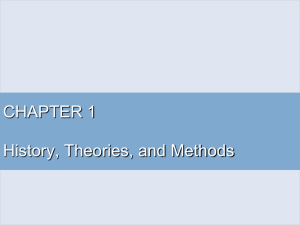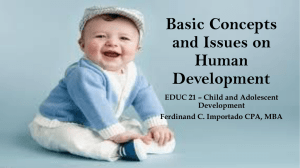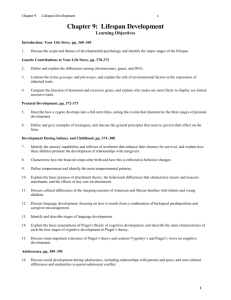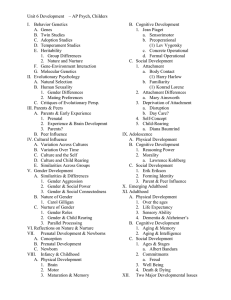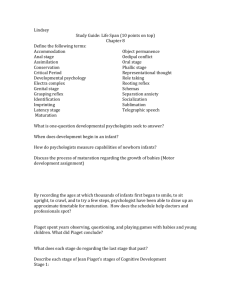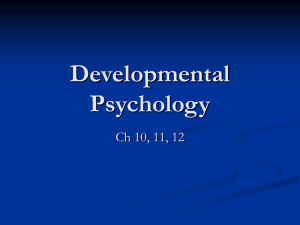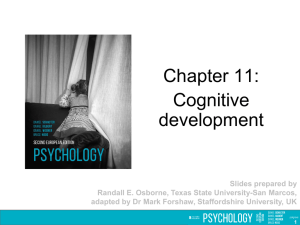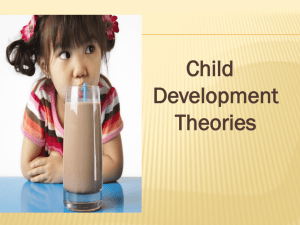CHAPTER 1 History, Theories, and Methods
advertisement
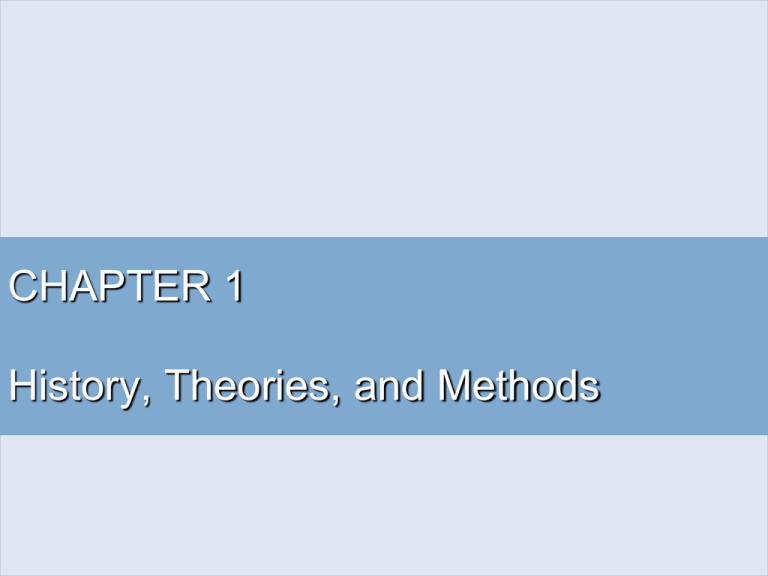
CHAPTER 1 History, Theories, and Methods The Development of the Study of Development The Life-Span Perspective • Development – the pattern of movement or change that begins at conception and continues through the human life span – each of us develops • partly like all other individuals • partly like some other individuals • partly like no other individuals More Characteristics of the Life-Span Perspective • Life-span perspective views development as – Lifelong – Multidimensional – Multidirectional – Dynamic systems » Butterfly effect – Plastic – Multidisciplinary • What other disciplines contribute to the study of the life-span? – Contextual – Historical context » » Cohort – Examples: Wifely duties, 9/11, Great Depression, Bonfire Social construction – Socioeconomic context (Socioeconomic status) – Cultural context (Culture) » Subculture » Race vs. Ethnicity » Individualistic vs. Collective » Examples: Olympics, Korea, Self (Baltes, 1987, 2003; Baltes, Lindenberger, & Staudinger, 2006) Child Development Pioneers • John Locke – Believed children came into the world as a “tabula rasa,” or blank slate • Jean-Jacques Rousseau – Believed children were inherently good, and when allowed to express natural impulses, generous morality would develop Child Development Pioneers (cont’d) • G. Stanley Hall – Founded child development as an academic discipline and focused scientific attention on the period of adolescence • Alfred Binet/Theodore Simon – Developed first standardized intelligence test intended to help public school children at risk of falling behind their peers in academic achievement Adult Development Theorists • William Perry/Gisella Labouvie-Vief – Studied cognitive complexity from adolescence to late adulthood • K.W. Schaie – Studied trends in various mental abilities throughout middle and late adulthood Theories of Development Developmental Theories • Learning theory – Stressed the importance of the physical and social environments (nurture) (John B. Watson) • Maturation view – Stressed the importance of biological maturation as the main force in development (nature) (Arnold Gessell) • Psychoanalytic perspective – Stressed the importance of conflicts between opposing inner forces (Freud) Freud’s Theory of Psychosexual Development • Focused on emotional and social development • Focused on the origins of psychological traits – dependence, obsessive neatness, and vanity • Three parts of the personality - Id • Present at birth; unconscious • Represents biological drives • Demands instant gratification - Ego • Conscious sense of self • Seeks gratification but avoids social disapproval - Superego • Conscious • Monitors the intentions and behavior of ego by allowing guilt and shame Five Stages of Psychosexual Development • Stage 1 – Oral stage Focus on oral activities such as sucking and biting during first year of life • Stage 2 – Anal stage Focus on control and elimination of bodily waste products Toilet training stage of life • Stage 3 – Phallic stage Focus on parent/child conflict over child’s personal sexual exploration • Stage 4 – Latency stage Focus on schoolwork Sexual feelings remain unconscious Children play with same sex playmates • Stage 5 – Genital stage Begins with biological changes in adolescence resulting in desire for intercourse Contributions of Freudian Theory • Stimulated various research areas • Influenced how childcare workers approach infants, toddlers, and preschoolers • Influenced teachers’ sensitivity to students’ emotional needs • Influenced the stage models of other theorists such as Erikson Limitations of Freudian Theory • Theory developed from his interactions with adult patients (mostly women) • May have inadvertently guided patients’ reports to confirm his views • Overemphasized basic instincts and unconscious motives Erikson’s Psychosocial Development • Focused on development of – emotional life – psychological traits – self-identity • Looked at importance of social relationships, but emphasis was on the ego (sense of self) • Viewed physical maturation as a major contributor to development • Viewed that early experiences affect future developments and/or accomplishments • Successful resolution of early life crises bolster sense of identity Erikson’s Psychosocial Stages Eight Stages of Psychosocial Development • Stage 1 – Trust vs. mistrust (age 1) • Stage 2 – Autonomy vs. shame/doubt (ages 1-3) • Stage 3 – Initiative vs. guilt (ages 3-5) • Stage 4 – Industry vs. inferiority (ages 6-12) • Stage 5 – Identity vs. confusion (ages 12-18) • Stage 6 – Intimacy vs. isolation (young adulthood) • Stage 7 – Generativity vs. self-absorption (middle adulthood) • Stage 8 – Integrity vs. despair (late adulthood) Contributions of Erikson’s Theory • Emphasized importance of human consciousness and choice • Portrayed human development as prosocial and helpful • Some empirical support that positive outcomes of early life crises help put us on path to positive development Behavioral Theory • Classical conditioning – Developed by Pavlov – Learning in which a neutral stimulus elicits the response usually brought forth by a second stimulus through repeated pairings with the second stimulus • ex. Examples: Squeaky door, Ice cream man, “Take out a sheet of paper…” • Operant conditioning – Developed by Skinner – Learning in which an organism learns to engage in behavior that is reinforced • Example: child learns to adjust behavior to conform to social codes and rules to earn reinforcers such as attention and approval • Examples: traffic, “Why won’t she listen the 1st time?” Fig. 1-1, p. 6 Reinforcement • Positive reinforcers – Increase the frequency of behaviors when they are applied • ex. food and approval • Negative reinforcers – Increase the frequency of behaviors when undesirable states are removed • ex. fear of failure is removed when one studies for a test • Extinction – Results from repeated performance of operant behavior without reinforcement • ex. child’s temper tantrum stops when parent leaves the room Fig. 1-2, p. 7 Fig. 1-3, p. 7 Punishment • Punishment: aversive events that suppress or decrease the frequency of the behavior they follow • Punishment CONS – Does not suggest alternative acceptable behavior – Suppresses undesirable behavior only when its delivery is guaranteed – Can create feelings of anger and hostility Social-Cognitive Theory • Developed by Bandura – Learning occurs • by observing other people • by reading • by viewing characters in the media • Observational learning occurs by the modeling of a behavior to another person – Examples: Child at Aggie game, becoming our parents Cognitive-Developmental Theory • Developed by Piaget – Intrigued by children’s wrong answers – Children seen as active participants • Scheme – Action pattern or mental structure involved in acquiring or organizing knowledge • Adaptation – Interaction between the organism and the environment • Assimilation – The incorporation of new events or knowledge into existing schemes • Accommodation – The modification of existing schemes to permit the incorporation of new events or knowledge • Equilibration – Achieving a balance between assimilation and accommodation Piaget’s Cognitive Stages Four Stages of Cognitive Development • Stage 1 – Sensorimotor (birth to 2 years) – focus on sensory exploration; object permanence mastered • Stage 2 – Preoperational (2-7 years) – focus on language and symbolic expression through play; children are egocentric • Stage 3 – Concrete operational (7-12 years) – focus on mastering concepts such as reversibility • Stage 4 – Formal operational – ability to reason abstractly (12 years and older) Information-Processing Theory • Based on computer model of information processing • Cognitive process of – encoding information (input) – storing the information into long-term memory – retrieving the information (or placing it in shortterm memory) – manipulating the information to solve problems • Most applicable to the teaching of methodological steps • ex: teaching the scientific method The Biological Perspective Directly relates to physical development: – – – • gains in height and weight development of the brain developments connected with hormones, reproduction, and heredity Two primary theories – – Evolutionary psychology Ethology Evolutionary Psychology • Studies the ways in which adaptation and natural selection are connected with mental processes and behavior – Behavior patterns that help an organism to survive and reproduce are likely to be transmitted to the next generation – Fixed action patterns • A stereotyped pattern of behavior evoked by a “releasing stimulus,” an instinct The Ecological Perspective • Ecology – The branch of biology that deals with the relationships between living organisms and their environment • Bronfenbrenner – Looked at two-way interactions between the child and the parents, not just maturational forces (nature) or childrearing practices (nurture) Bronfenbrenner’s Systems Approach • Microsystem – interactions of the child with other people in the immediate setting such as the home, school, or peer group • Mesosystem – interactions of various settings with the microsystem such as a parent-teacher conference or a school field trip to the zoo • Exosystem – institutions that indirectly affect the development of the child such as the school board or the parent’s place of employment • Macrosystem – interaction of the child with the beliefs, expectations, and lifestyle of his/her cultural setting • Chronosystem – the influence that changes over time have on development Fig. 1-4, p. 11 The Sociocultural Perspective • Developed by Vygotsky • Teaches that people are social beings who are affected by the cultures in which they live • Focuses on the transmission of information and cognitive skills from generation to generation • Views that learning consists of social engagement from a more skilled individual to a lesser skilled individual – ex: an older sibling teaching a younger sibling to ride a bike Sociocultural Terms • Zone of proximal development (ZPD) – range of tasks that a child can carry out with the help of a more skilled apprentice • Scaffolding – problem-solving methods such as cues provided to the child to increase independent functioning • Diversity – one’s ethnicity, race, gender, age, etc. Connecting Biological, Cognitive, and Socioemotional Processes • Inextricably intertwined • Two emerging fields – Developmental cognitive neuroscience • Examples: Alzheimer’s disease, ADHD – Developmental social neuroscience • Examples: Austism, failure to thrive • Bidirectional Controversies in Development The Nature/Nurture Controversy • Which is more influential in development – nature (heredity) or nurture (environmental influences)? • Natural causes – Genetics – Nervous system functioning – Maturation • Environmental causes – Nutrition – Cultural and familial backgrounds – Educational opportunities The Continuity/Discontinuity Controversy • Continuous perspective views development as – a process where the effects of learning mount gradually with no major sudden qualitative changes • Discontinuous perspective views development as – a number of rapid qualitative changes that usher in new STAGES of development – biological changes provide the potential for psychological changes • Freud and Piaget were discontinuous theorists The Active-Passive Controversy • Active perspective – maintains children are actively engaged in their development • ex: child viewed as willful and unruly • Passive perspective – maintains that children are passive and the environment acts on them to influence development • ex: child viewed as blank tablets How Do We Study Development? Developmental Research Methodologies • Naturalistic observation – research conducted in natural setting – in “the field” • Examples: Bullying, marriage • Case study – carefully drawn account of an individual’s behavior • Examples: Autism, SIDS Correlational Studies • Correlation – attempt to determine whether one behavior or trait being studied is correlated with another; never indicates cause and effect • Correlation coefficient – number ranging from -1.00 to +1.00 that expresses the direction and strength of the relationship between two variables • Positive correlation » Examples: Temperament, reporting domestic violence, Gossip/depression/anxiety • Negative correlation » Examples: Overtime/anxiety/depression, Cohabitation Fig. 1-5, p. 16 The Experiment • Preferred method for investigating questions of cause and effect • One group receives the treatment and the other group does not • Experiments test a hypothesis • Experiments have independent and dependent variables – independent variable is manipulated – dependent variables are the measured results – Examples: DHA, UMP, choline Intelligence? » Violence Aggression Experiments (cont’d) • Experimental group – receives the treatment • Control group – does not receive the treatment • Random assignment – subjects assigned to a group randomly • Ethical/practical considerations – researchers look at the assignment of participants; sometimes correlational evidence must be settled for rather than experimental • Animal subjects – used to generalize findings to humans when it is not ethical or practical to use humans in the experiment Longitudinal Research • In longitudinal research – same people are observed repeatedly over time, and changes in development are recorded • Typical time of study spans months or a few years • Longitudinal researchers must enlist future researchers to continue the study Cross-Sectional Research • Cross-sectional research observes and compares subjects of different ages – a larger number of participants is needed for this type of study • Cohort effect – Group of people born at the same time will experience cultural and other events unique to age group Cross-Sequential Research • Combines longitudinal and cross-sectional methods to overcome research drawbacks • Breaks up the full span of the ideal longitudinal study into convenient segments • Minimizes the number of years needed to complete a study • Uses time-lag comparisons • Example: Problem-solving skills Fig. 1-6, p. 19 Ethical Considerations • Do not use methods that may cause physical or psychological harm • Inform participants of the purposes of the research and its methods • Participation must involve voluntary consent • Participants may withdraw from study at any time, for any reason • Participants are offered information about the results of the study • Identities of participants remains confidential • Research plans are to be presented to a committee of colleagues and gain approval before proceeding
